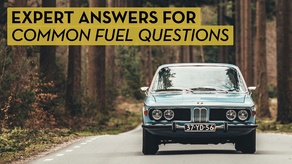While I collect vintage cars, my greater passion is vintage motorcycles. My modest collection numbers roughly 30 bikes, mostly popular British (BSA, Triumph, Norton, Velocette, Matchless), and some old Harleys, BMWs,. etc). As ethenol-based fuels came into general use, many of these otherwise finely-fettled machines ran increasingly poorly (decreasingly well?). I was introduced to VP Racing Fuels by a mechanic friend and experimented with their VP110, which is a 110 octane leaded gasoline.
As an example, my 1962 Norton Atlas, a twin-cylinder 750cc machine with a compression ratio of 8:1 (after one of my rebuilds over 40+ years of ownership) was running poorly, especially on hot days, under load and two-up. "Pinking" as the Brits would say...pre-ignition. Plus blueing exhaust pipes, loss of power, oveheating maladies, etc. No amount of dialing in the timing, mixture, etc., would help. Not a happy machine.
I experimented with a blue, 5-gallon drum of the precious stuff ($11/gallon then, more like $15/gallon now). With 100% VP110, my ol' Norton ran like new—not only starting easier, but the throttle response was noticeably quicker and power so linear and reliable, I could torque my way up long uphills in top gear, two-up, on a hot Southern California day with nary a protest from the happy machine.
So I tried a 50% mixture with pump premium, considering the high running costs. Also brillaint. And so I dialled back to 25% VP110. Still a splendid result. Then 15%. At this point, I noticed a drop-off in benefit. So I locked in that 25% VP110 to 75% Pump Premium and after all these years, it's still the go-to Magic Elixir! I use it in any motorcycle that originally lived on a diet of leaded premium fuel, or whose compression ratio was increased to require such octane enhancement. VP also has non-leaded fuels and many octane ractings for a myriad of applications.
Note that this fuel is not approved for street use and you will need to fill out a form at point of purchase declaring that the machine in which it will be used will only be used in off-road (or roadracing) activities. Wink-wink.
Your mileage may vary.
~ Dave Destler

























